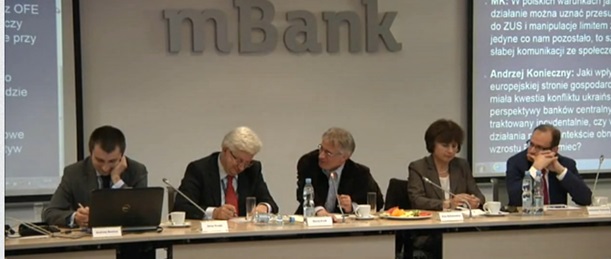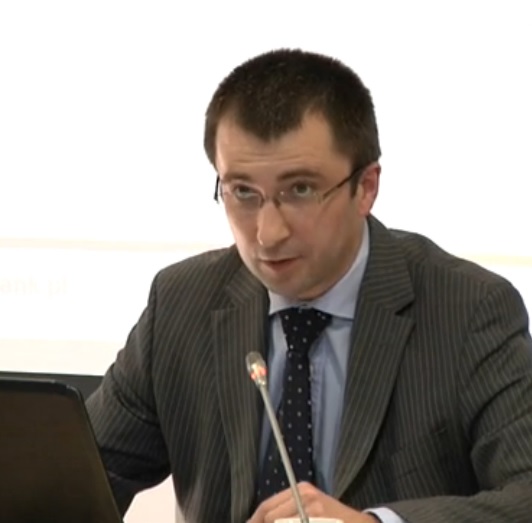The consequences of the unconventional monetary policy: what central banks do not take into account?
 „In 2009, the world economy contracted for the first time since the end of the World War II. It was a result of an unexpected by the majority of economists economic downturn in the most developed countries (…).
„In 2009, the world economy contracted for the first time since the end of the World War II. It was a result of an unexpected by the majority of economists economic downturn in the most developed countries (…).
In a response to the outbreak of the global crisis, the main central banks, namely the Fed and the European Central Bank (ECB), resolved to take some unconventional actions: (i) reducing interest rates to close to zero, (ii) committing to keep interest rates that low for a long time, (iii) introducing quantitative easing on a large scale. The first measure brought upon the longest period of the negative real interest rates since the 1970’s, the second one made many people believe that this state would last for the next couple of years, while the third led to the tripling of the central banks’ balance sheets.
On the whole, the responses of the main central banks were in line – although not entirely - with main conclusions of the new Keynesian analytical scheme, which is used as a theoretical framework for monetary policy. According to this approach, had the main central banks not adopted those unconventional measures, the total demand, and in turn also the economic growth, would have been even weaker.
However, the new Keynesian analytical scheme does not enable to analyze any of the following post-crisis problems: a low rate of bankruptcies in the world’s biggest economies; a small number of enterprises entering the market (even in places such as the United States, where net profits of enterprises in relation to the GDP reached the all-time-high); a very low employee turnover rate; a significant persistence of the economic uncertainty although the volatility of macroeconomic indicators has been low; low dynamics of money supply despite the dramatic increase in the monetary base; and the unprecedented during the peacetime public debt growth, which reached levels impossible to sustain with normal interest rates. To put it simply, this scheme does not includes mechanisms through which the unconventional monetary policy may generate costs.”

These costs where the topic of the discussion during the 131st mBank-CASE Seminar. The main guest speaker, dr. Andrzej Rzońca, applied the new Keynesian analytical scheme to evaluate the results of the monetary policy introduced in reaction to the crisis, and compared them with the outcomes of the unconventional actions undertaken by the major central banks. He then discussed the impact of the unconventional policies on restructuring, uncertainty, lending, money supply dynamics, and public debt. In other words, he described main cost-generating mechanisms, which in his view stemmed “not only from distortions in the economic choices of the households, businesses, and banks, but also from the fiscal authorities’ decisions, especially in terms of the size of deficit in the public finance.”
Following dr. Rzonca’s presentation, dr. Jerzy Pruski and dr. Dobiesław Tymoczko delivered their commentaries.
Dr. Pruski first briefly discussed the causes of the last financial crisis, and then explained why he agrees with dr. Rzonca on his assessment of the adverse results of the unconventional monetary policy. In his opinion, though, the application of any macroeconomic policy instruments, fiscal or monetary ones, will not be effective until the true cause of the crisis – an excessive and toxic indebtedness – is dealt with. An adoption of the alternative monetary policy without the debt reduction would mean an increase in the credit burden, and higher interest rates undoubtedly leading to deflation – the worst possible scenario for the debtors. As dr. Pruski argued, incumbents had to choose between the reality of managing the leverage cycle in the long term, or a fast restructuring introduced by means of undertaking more aggressive macroeconomic actions. The latter option would in his opinion cause a far deeper downturn, despite the mechanics explained by dr. Rzonca.

Dr. Tymoczko, for his part, emphasized that although in principle he agrees that the theory – new Keynesian analytical scheme – does not justify the use of quantitative easing, the practice does. In his view, central banks had at least four reasons to adopt this measure: providing drying up markets with liquidity, signaling through the purchase of the assets considered to be toxic that they are not completely worthless, trying to revive the markets, and recapitalizing the banks.
Moreover, he disagreed with dr. Rzonca that the central banks’ reaction had fueled uncertainty. In his opinion not only the uncertainty would have appeared regardless of banks’ actions, but it might have been even bigger had the banks decided not to react at all. Dr. Tymoczko also argued that the fast restructuring, so appraised by dr. Rzonca, would have far-reaching, yet not mentioned by him consequences - in the short term it would lead to a deepening of the recession, or at the very least would be a serious obstacle to the recovery. To sum up – he stressed that although many arguments presented by dr. Rzonca made perfect sense, the benefits, not only the costs of the unconventional monetary policy, as well as possible alternative solutions, should have been discussed by him as well.
The Seminar was concluded by a discussion between guests and on-line participants.
 The video of the seminar is available at Bankier.TV
The video of the seminar is available at Bankier.TV
The interview with Andrzej Rzonca that took place after the Seminar ("Low inflation in the eurozone is demonized") is available here.
Dr Rzonca’s PowerPoint presentation may be find here.
*All quotations come from the analysis “Consequences of the unconventional monetary policy: what central banks don’t take into account?”, prepared by dr. Andrzej Rzonca and dr. Piotr Cizkowicz, which will be published in June within mBank-CASE Seminar Proceedings series.
Do not miss our future events - sign up for our newsletter or follow us on facebook.

